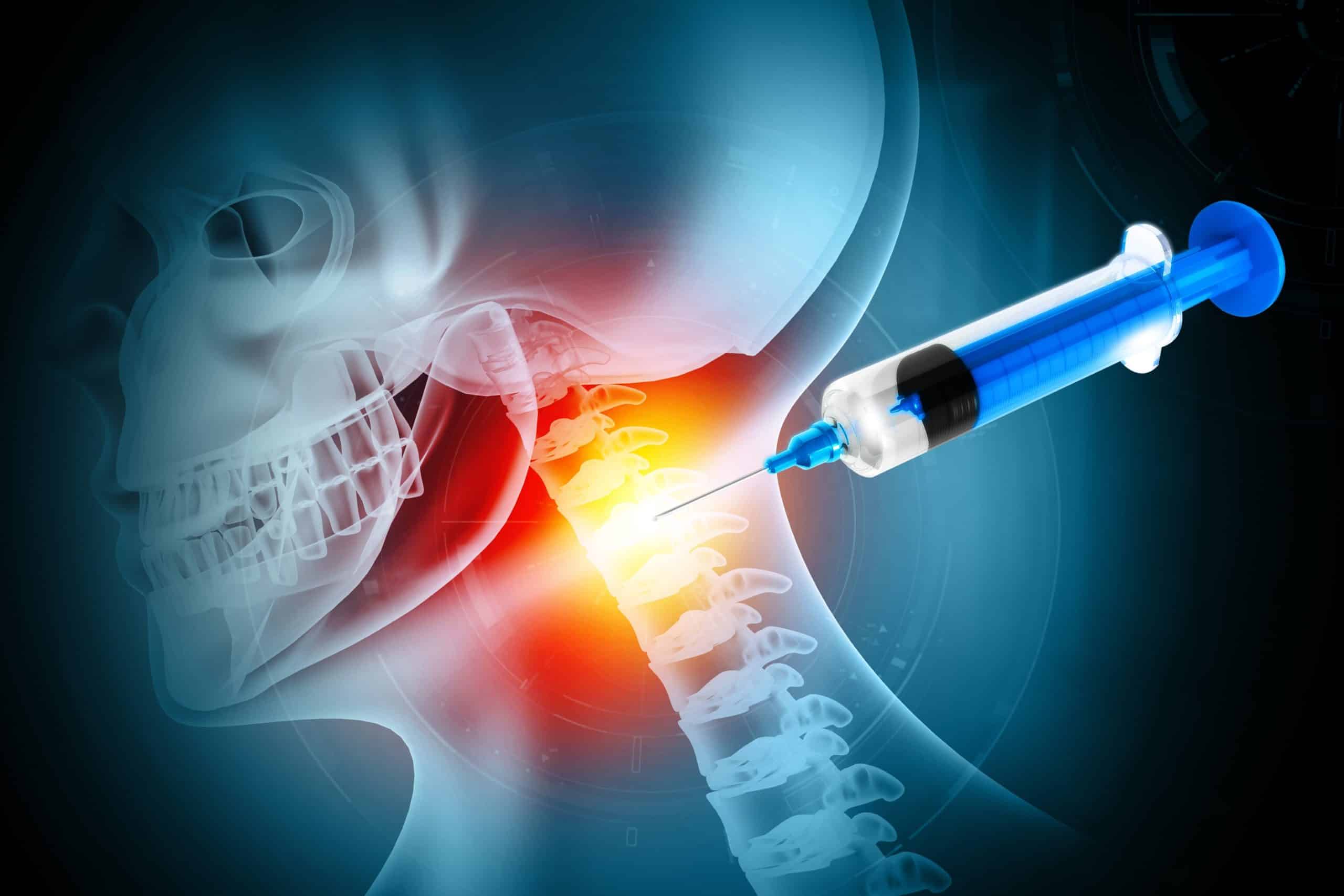Marc Darrow, MD., JD.
Many people find relief from neck pain through various non-surgical treatments. Among these conservative neck care treatments are neck epidural corticosteroids injections. These steroid injections can provide temporary relief in situations of chronic neck pain and in cervical radiculopathy where inflammation is causing compression the cervical nerves and pain and numbness into the arms, hands and fingers. However, long-term results can be less successful. Below we will explore some recent research.

Cervical epidural steroid injection and eventual surgery
An October 2021 study (1) investigated the effect of preoperative epidural steroid injection on future outcomes in patients undergoing surgery for cervical degenerative disease. In this large study:
- 97,117 patients underwent cervical degenerative surgery, of which 29 963 (30.7%) had epidural corticosteroids injections before the surgery.
- Overall, 90-day complication rate was not significantly different between groups.
- The epidural corticosteroids injection patient had shorter length of hospital stay, but higher 90-day readmission and reoperation rates.
- Epidural corticosteroids injections use was associated with more healthcare needs through the 2-year follow-up period.
- Conclusion: Epidural corticosteroids injections can offer pain relief in some patients non-responsive to treatment neck problems than other conservative management techniques, but those who eventually undergo surgery have greater healthcare resource utilization.
In a November 2023 follow up study (10) of 201 patients in following cervical transforaminal epidural steroid injections, had similar and consistent results with previous studies showing that patients following cervical transforaminal epidural steroid injections can achieve pain relief in the short-term. The study also found that older patients had a greater reduction in pain after injection.
Of note:
- Among the 201 patients who followed up, 62 (30.8 %) went on to have cervical spine surgery.
A December 2023 study (9) tested the effectiveness of cervical transforaminal epidural steroid injections for the treatment of cervical radicular pain. In this study patients were followed 12 months after injection.
- 33 consecutively enrolled participants (63.6% females, average age about 51 years-old and on average considered overweight) were analyzed.
- A reduction in Numeric Rating Scale (NRS) for arm pain (0-10) of 64.5%was seen at 12 months.
- Improvement in Neck Disability scores were seen at 71% at 12 months.
- Conclusion: Statistically significant and clinically meaningful improvements in pain and disability were observed after cervical transforaminal epidural steroid injections for up to 12 months in individuals with unilateral cervical radicular pain.
For many people there is usually not a need for cervical epidural steroid injection to resolve flare ups of nerve inflammation in the neck
For many people there is usually not a need for cervical epidural steroid injection to resolve flare ups of nerve inflammation in the neck. Even fewer will need surgery. However the effectiveness, as point out above of these injections are questioned. Short-term results are usually good. This is pointed out in an August 2017 paper (2) which wrote “Conservative treatment options have been recommended in many reviews on cervical radiculopathy, ranging from different types of physiotherapy to waiting for remission by natural history (it resolves itself).” This study assessed a conservative care based multi-treatment plan with focus on cervical translaminar epidural steroid injection for patients with cervical radiculopathy.
- 54 patients who had undergone an inpatient multi-treatment plan for 10 days were evaluated before and after 10-days treatment.
- Neck pain was reduced by 57.4% and arm pain by 62.5%. 2 days after epidural steroid injection, pain was reduced by 40.1% in the neck and by 43.4% in the arms.
- MPM seems to be an efficient short-term approach to treating cervical radiculopathy. Cervical translaminar epidural steroid injection is an important part of this concept.
A May 2022 paper (5) followed up by testing the effectiveness of cervical epidural injections of local anesthetic with vs. without a steroid. In reviewing data from four previously published studies of treatment with lidocaine alone or with the steroid resulted in “evidence that cervical epidural injections with lidocaine alone or in combination with the steroid betamethasone alleviated pain and improved functionality in patients with neck pain.” In fact the outcomes were very similar calling into question the need for the steroid. “there were no differences observed between treatment with anesthetic alone or in conjunction with a steroid in the 4 (clinical trial outcome data) is that both agents play the same roles in pain relief and functional improvement. ” The researchers write: “Given the risks and adverse effects associated with both types of drug and potential interaction effects, additional studies are needed to determine whether the 2 treatments are equally effective, in which case the use of steroids can be avoided.”
A 2019 paper (3) evaluate the patient-reported outcomes and satisfaction from cervical epidural steroid injection during a 2-year follow-up. In 34 cases transforaminal cervical epidural steroid injection for cervical radiculopathy was shown to be an effective non-surgical treatment option, providing significant pain relief and functional improvement during 2-years follow-up along with higher-than-average patient satisfaction in most of (the study’s) patients.
This was further demonstrated in a 2020 paper (4).
“Despite many clinical trials on cervical epidural steroid injections, the indications for and long-standing outcomes of this treatment remain controversial. We evaluated the outcomes and indications for transforaminal cervical epidural steroid injection in patients with moderate to severe disability.” In this study patients with 1 or 2-level cervical degenerative disease (herniated disc, foraminal stenosis) with moderate to severe disability and greater than 12 weeks of pain, despite conservative treatment were examined.
Patients with persistent disability and those who desired surgical intervention underwent decompression surgery. The clinical and demographic characteristics were compared between groups. Of the 309 patients who underwent transforaminal cervical epidural steroid injection, 221 (72%) did not receive surgical treatment during the 1-year follow-up period. The remaining 88 patients (28%) underwent surgery at an average of 4.1 months after initial transforaminal cervical epidural steroid injection. Patients who underwent injection alone showed a significant decrease in disability and pain that persisted until the 1-year follow-up visit. In patients who underwent surgery, the mean disability and pain scores after injection did not decrease for several months, although the scores significantly decreased up to 1 year after surgery. The transforaminal cervical epidural steroid injection significantly decreased pain and disability in the moderate to severe disability group up to 1 year after injection. (The researchers) recommend cervical transforaminal cervical epidural steroid injection as an initial treatment with moderate to severe disability patients.”
As seen in the research above generally there is a controversy in medicine as to the short-term and long-term benefits of cervical epidural injections for pain relief
As seen in the research above generally there is a controversy in medicine as to the short-term and long-term benefits of cervical epidural injections for pain relief, however, there is a consensus that many patients can experience significant pain relief in the short-term but this pain relief may come with long-term consequences. Many studies measure the effects of a single epidural however for people with persistent neck pain often have repeat injections. The need for further injections is based on the current condition and situation of the patient’s degenerative cervical spine problems. Repeated injections may offer a better outcome than single injection however there is risk of involved with corticosteroid use.
A 2023 study (6) investigated treatment success after interlaminar epidural steroid injection in radicular pain induced by cervical disc herniation. In 92 patients with unilateral radicular neck pain due to cervical disc herniation, at six months after interlaminar epidural steroid injection, treatment was successful in 58 (58.7%) patients and unsuccessful in 34 (41.3%) patients. Neural foraminal stenosis (non-severe vs. severe) and spinal canal stenosis (non-severe vs. severe) were significantly associated with the treatment success.
A February 2024 paper (7) compared ultrasound-guided selective nerve root pulsed radiofrequency and fluoroscopy-guided paramedian (between the spinal cord and spinal bones) cervical interlaminar epidural steroid injection in people with chronic cervical radicular pain. The researchers divided 60 patients into two groups, each receiving one treatment of the other.
- At three and six months following treatment, patient reported surveys showed a significant decrease in pain and function scores. Both treatments effectively improved neuropathic pain. Each treatment worked just as well as the other.
A September 2024 study (11) called into question the use of cervical and lumbar epidural spinal injections to address back pain and/or painful radiculopathy. The three major types of injections include; interlaminar/translaminar (ESI), transforaminal (TFESI), or caudal injections. The researchers write: “Notably, most studies document little to no clear short-term, and no long-term benefits/efficacy for these injections vs. various placebos.” In addressing possible side-effects the researchers noted more adverse events occurred with cervical rather than lumbar injections, and more severe adverse events were attributed to cervical transforaminal vs. cervical interlaminar/translaminar injections.”
Alternatives to cervical spine corticosteroid injections
An August 2021 paper (8) suggested that Plasma rich in growth factors (PRGF) is an effective biological approach to tissue repair and has been demonstrated to significantly improve multiple conditions, including low back pain and degenerative disc pathology. This treatment falls under the umbrella of Platelet rich Plasma injections.
- PRP injections are prepared by collecting a small amount of your blood and spinning it in a centrifuge to separate the platelets from the red cells. The collected platelets are then injected back into the injured area to stimulate healing and regeneration.
- The platelets contain healing agents, or “growth factors.” including Platelet-derived growth factor (PDGF), Transforming growth factor beta (or TGF-β, Insulin-like growth factors, Vascular endothelial growth factor (VEGF) and Epidermal growth factors.
This study included 65 patients (18 with cervical pain and 47 with lumbar back pain). The average time of back pain evolution was 10 years. Patients received at least two plasma rich in growth factors injections about one month apart. Each patient received intervertebral disc and epidural injections, root infiltrations, in case of radicular injury, and intraarticular infiltrations, in case of osteoarthritis of the facet joints. Results show statistically significant improvements on all analyzed scores. Conclusions: According to the results obtained in this study, and taking into account their limitations, PRGF infiltrations are an effective and minimally invasive biological strategy in the treatment of both cervical and lumbar pain.
Call for a free phone consultation with our staff 800-300-9300
Related articles:
Information on Non-Surgical and Conservative Care for neck pain and cervical spine disorders
References
1 Wadhwa H, Varshneya K, Stienen MN, Veeravagu A. Do Epidural Steroid Injections Affect Outcomes and Costs in Cervical Degenerative Disease? A Retrospective MarketScan Database Analysis. Global Spine Journal. 2021 Oct 22:21925682211050320.
2 Benditz A, Brunner M, Zeman F, Greimel F, Florian V, Boluki D, Grifka J, Weber M, Renkawitz T. Effectiveness of a multimodal pain management concept for patients with cervical radiculopathy with focus on cervical epidural injections. Scientific Reports. 2017 Aug 11;7(1):1-9.
3 Hashemi M, Dadkhah P, Taheri M, Ghasemi M, Hosseinpour A, Farjam M. Patient-Reported Outcomes and Satisfaction after Cervical Epidural Steroid Injection for Cervical Radiculopathy. Galen Medical Journal. 2019;8:e1478.
4 Hong JY, Park JS, Suh SW, Yang JH, Park SY, Kim BT. Transforaminal epidural steroid injections in cervical spinal disease with moderate to severe disability: Comparative study in patients with or without surgery. Medicine. 2020 Feb;99(7).
5 Li BZ, Tang WH, Li Y, Zhou L, Liu MG, Bao SX. Clinical Efficacy of Epidural Injections of Local Anesthetic Alone or Combined with Steroid for Neck Pain: A Systematic Review and Meta-Analysis. BioMed Research International. 2022 May 26;2022.
6 Celenlioglu AE, Solmaz I, Eksert S, Simsek F, Ilkbahar S, Ender SI. Factors Associated with Treatment Success After Interlaminar Epidural Steroid Injection for Cervical Radicular Pain. Turkish Neurosurgery. 2023 Jan 1;33(2).
7 Yildiz G, Perdecioglu GR, Akkaya OT, Can E, Yuruk D. Comparison of Selective Nerve Root Pulsed Radiofrequency Vs Paramedian Interlaminar Epidural Steroid Injection for the Treatment of Painful Cervical Radiculopathy. Pain Physician. 2024 Feb;27:E221-9.
8 Anitua E. Plasma Rich in Growth Factors (PRGF) in the Treatment of Cervical and Lumbar Back Pain: A Retrospective Observational Clinical Study. Pain physician. 2021 Aug;24:E649-60.
9 Conger AM, Randall DJ, Sperry BP, Kuo KT, Petersen R, Henrie AM, Kendall RW, Bisson EF, Teramoto M, Martin BI, Burnham TR. The effectiveness of cervical transforaminal epidural steroid injections for the treatment of cervical radicular pain: A prospective cohort study reporting 12-month outcomes. Interventional Pain Medicine. 2024 Mar 1;3(1):100379.
10 Goyal KK, Kristoff TJ, Sinopoli JT, Abbott M, Thompson NR, Koech H, Rabah N. Benefit of pain and function after cervical transforaminal epidural steroid injections, an observational study. Interventional Pain Medicine. 2023 Dec 1;2(4):100299.
11 Epstein NE, Agulnick MA. Perspective: Risks/adverse events for epidural spinal injections. Surgical Neurology International. 2024;15(328):1.






